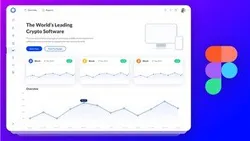
Responsive Website In Figma 
This course provides an introduction to responsive design in Figma. It reviews Appel and Figma's responsive design, and covers topics such as understanding layout grids, getting started with responsive design, and identifying column patterns for each breakpoint. Participants will gain the skills to create responsive websites in Figma. ▼
ADVERTISEMENT
Course Feature
![]() Cost:
Cost:
Free
![]() Provider:
Provider:
Youtube
![]() Certificate:
Certificate:
Paid Certification
![]() Language:
Language:
English
![]() Start Date:
Start Date:
On-Demand
Course Overview
❗The content presented here is sourced directly from Youtube platform. For comprehensive course details, including enrollment information, simply click on the 'Go to class' link on our website.
Updated in [February 21st, 2023]
Learners can learn how to create a responsive website in Figma. This course will cover the basics of responsive design, such as reviewing Appel & Figma's responsive design, understanding layout grids inside Figma, and getting started with responsive design in Figma. Learners will also learn how to identify column patterns for each breakpoint, allowing them to create a website that looks great on any device. Additionally, learners will gain an understanding of how to use Figma's features to create a website that is optimized for different screen sizes. Finally, learners will be able to apply their knowledge to create a website that is both visually appealing and functional.
[Applications]
The application of this course can be seen in the development of responsive websites. After completing this course, users will have a better understanding of Appel & Figma's responsive design, layout grids inside Figma, and how to get started with responsive design in Figma. They will also be able to identify column patterns for each breakpoint. This knowledge can be used to create responsive websites that are optimized for different devices and screen sizes. Additionally, users can use this course to create a better user experience for their website visitors.
[Career Paths]
1. Web Designer: Web designers create the look, layout, and features of a website. They are responsible for the visual elements of a website, including the layout, color scheme, and font. They also work with content creators to ensure the website is user-friendly and visually appealing. With the increasing demand for mobile-friendly websites, web designers must be knowledgeable in responsive design principles and techniques.
2. Front-End Developer: Front-end developers are responsible for coding the front-end of a website. They use HTML, CSS, and JavaScript to create the user interface and ensure the website is responsive and optimized for different devices. As the demand for mobile-friendly websites continues to grow, front-end developers must be knowledgeable in responsive design principles and techniques.
3. UX/UI Designer: UX/UI designers are responsible for creating the user experience and user interface of a website. They use research and testing to create a website that is user-friendly and visually appealing. With the increasing demand for mobile-friendly websites, UX/UI designers must be knowledgeable in responsive design principles and techniques.
4. Digital Marketer: Digital marketers are responsible for creating and executing marketing campaigns for websites. They use a variety of digital marketing techniques, such as SEO, PPC, and social media, to drive traffic to a website and increase conversions. As the demand for mobile-friendly websites continues to grow, digital marketers must be knowledgeable in responsive design principles and techniques.
[Education Paths]
1. Bachelor of Science in Computer Science: This degree path focuses on the fundamentals of computer science, such as programming, software engineering, and computer architecture. It also covers topics such as artificial intelligence, machine learning, and data science. This degree path is becoming increasingly popular as technology continues to evolve and become more complex.
2. Bachelor of Science in Web Design and Development: This degree path focuses on the design and development of websites and web applications. It covers topics such as HTML, CSS, JavaScript, and other web development languages. It also covers topics such as user experience design, web analytics, and search engine optimization. This degree path is becoming increasingly popular as businesses continue to rely on the web for their operations.
3. Bachelor of Science in Digital Media: This degree path focuses on the creation and management of digital media, such as video, audio, and images. It covers topics such as digital video production, audio engineering, and digital photography. This degree path is becoming increasingly popular as digital media continues to become more prevalent in our lives.
4. Bachelor of Science in Information Technology: This degree path focuses on the management and security of information systems. It covers topics such as network security, database management, and system administration. This degree path is becoming increasingly popular as businesses continue to rely on technology for their operations.
Course Provider

Provider Youtube's Stats at AZClass
Discussion and Reviews
0.0 (Based on 0 reviews)
Explore Similar Online Courses

Chess Classics You must Know Ep 25 Sultan Khan vs Capablanca 1930 Genius!

Build & Integrate your own custom chatbot to a website (Python & JavaScript)

Python for Informatics: Exploring Information

Social Network Analysis

Introduction to Systematic Review and Meta-Analysis

The Analytics Edge

DCO042 - Python For Informatics

Causal Diagrams: Draw Your Assumptions Before Your Conclusions

Whole genome sequencing of bacterial genomes - tools and applications

From idea to MVP without coding Intro to Figma & Bravo

Learn How to Design a Website in Figma


Start your review of Responsive Website In Figma